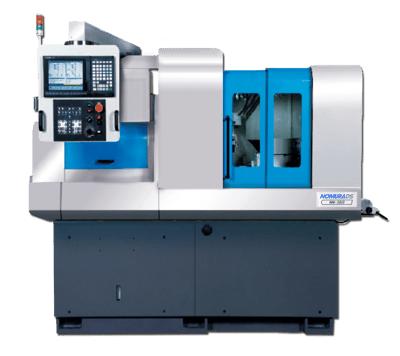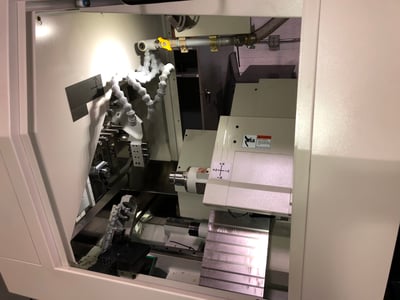The CNC Swiss-type lathe is a niche machine, once believed to be best suited for making long, small and complex parts. It is a variety of turning machine that typically feeds bar stock through a guide bushing. This allows tooling to work on the part close to the point of support. This increased stability offers the ability to machine delicate parts with tight tolerances at higher speeds. Swiss-types also have the ability to mill complex parts, which is becoming more and more necessary in today’s industry.
When choosing a Swiss-style lathe, you should consider factors such as part complexity, tolerance, and barstock size.

Swiss machines are capable of reducing or downright eliminating the need for multiple operations. This cuts back on the amount of part handling required on a given part, resulting in double or better productivity. By utilizing a moving headstock and guide bushing, a Swiss-type CNC can provide more stability and rigidity in its process than its traditional counterpart, which can provide these three benefits:
With firm support right next to the point of cutting, the machine keeps the part steady and unaffected by the force of the tools. Even when machining incredibly small parts, a Swiss machine can easily maintain precision within extremely tight tolerances.
Increased stability and well-supported bar stock, along with an extensive array of tooling, allow the production of more intricate parts with more delicate features. The machine can create thinner walls and deeper cuts that would be harder to achieve on traditional lathes.
Swiss machines boast an impressively short cycle time in comparison to standard CNC machines. Where other machines make longer movements and take time to index turrets, Swiss machining can easily produce many more parts with short, quick tool movements.
Swiss machines are more effective in high-volume environments, due to their quick cycle times. Unlike a traditional lathe that usually has three to five axes, a Swiss-type can have up to 13. With backside tooling and increased part stability, a Swiss CNC can machine more delicate parts up to 30% faster.
Swiss machines are primarily best for processing parts made from bar stock up to 1 1/2" in diameter and complex parts. For larger parts with less intricacy, a traditional CNC may be more suited.

Our unique hand-scraping process creates air and oil pockets that minimize friction along the machine ways. These perfectly flat surfaces then have less stress, which helps maintain the machine's precision over time.
Nomura's world-recognized rigidity is enhanced through the precise contact built into our dovetail structures. Creating parts accurately requires extremely rigid machines, and we pride ourselves on our ability to hold that rigidity.
Nomura machines are built on a solid cast foundation carefully engineered to absorb machining stresses and tolerance specifications affected by such variables as temperature change. The coolant tank designed into the casting bed is an excellent example of temperature control.